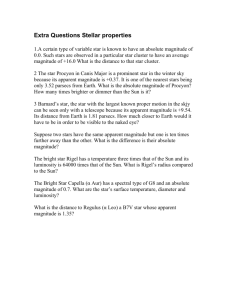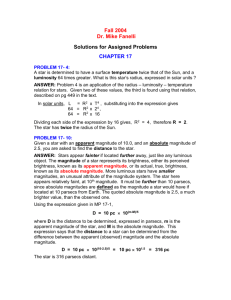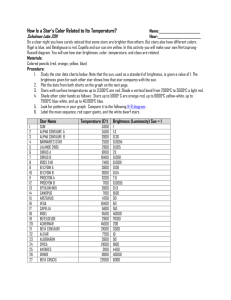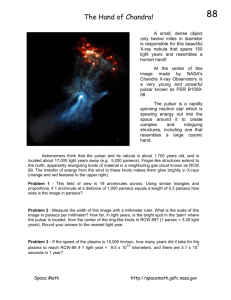ASTRONOMY 104 Magnitudes, the Hertzsprung – Russell diagram
advertisement
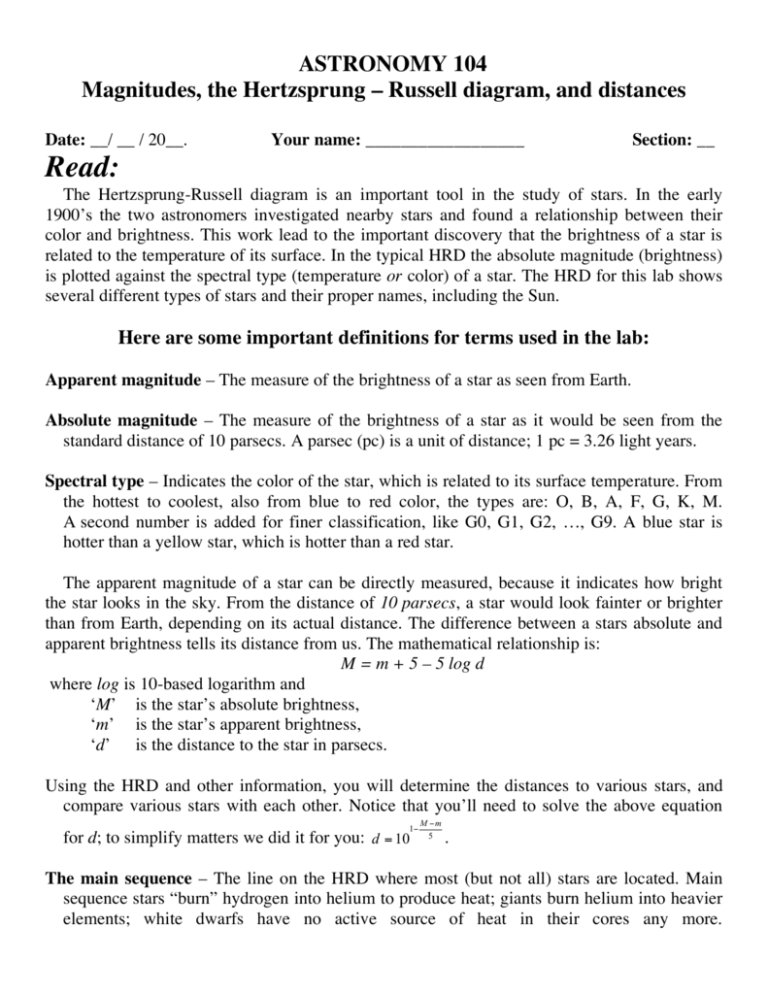
ASTRONOMY 104 Magnitudes, the Hertzsprung – Russell diagram, and distances Date: __/ __ / 20__. Your name: __________________ Section: __ Read: The Hertzsprung-Russell diagram is an important tool in the study of stars. In the early 1900’s the two astronomers investigated nearby stars and found a relationship between their color and brightness. This work lead to the important discovery that the brightness of a star is related to the temperature of its surface. In the typical HRD the absolute magnitude (brightness) is plotted against the spectral type (temperature or color) of a star. The HRD for this lab shows several different types of stars and their proper names, including the Sun. Here are some important definitions for terms used in the lab: Apparent magnitude – The measure of the brightness of a star as seen from Earth. Absolute magnitude – The measure of the brightness of a star as it would be seen from the standard distance of 10 parsecs. A parsec (pc) is a unit of distance; 1 pc = 3.26 light years. Spectral type – Indicates the color of the star, which is related to its surface temperature. From the hottest to coolest, also from blue to red color, the types are: O, B, A, F, G, K, M. A second number is added for finer classification, like G0, G1, G2, …, G9. A blue star is hotter than a yellow star, which is hotter than a red star. The apparent magnitude of a star can be directly measured, because it indicates how bright the star looks in the sky. From the distance of 10 parsecs, a star would look fainter or brighter than from Earth, depending on its actual distance. The difference between a stars absolute and apparent brightness tells its distance from us. The mathematical relationship is: M = m + 5 – 5 log d where log is 10-based logarithm and ‘M’ is the star’s absolute brightness, ‘m’ is the star’s apparent brightness, ‘d’ is the distance to the star in parsecs. Using the HRD and other information, you will determine the distances to various stars, and compare various stars with each other. Notice that you’ll need to solve the above equation 1! for d; to simplify matters we did it for you: d = 10 M !m 5 . The main sequence – The line on the HRD where most (but not all) stars are located. Main sequence stars “burn” hydrogen into helium to produce heat; giants burn helium into heavier elements; white dwarfs have no active source of heat in their cores any more. Procedure: 1. Examine the HR diagram. Find the spectral type and absolute magnitude of the stars in the table. (Those not yet on the HRD will be filled in later.) Name Official name Sirius A The Sun α Canis Maioris - Spectral Color type Distance (light years) = Betelgeuse Rigel Proxima Alcyone Procyon The G2 star in # 5 Absolute magnitude ly km Apparent magnitude -1.4 -27.0 α Orionis β Orionis α Centauri C2 η Tauri in the Pleiades α Canis Minoris - 0.3 11.7 2. Cross out the wrong words, leaving the correct answer: • • • • Based on its position in the HRD, Proxima is hot or cool and bright or faint. Based on its position in the HRD, Betelgeuse is hot or cool and bright or faint. That makes it a red or blue giant or dwarf. Based on its position in the HRD, Rigel is hot or cool and bright or faint. That makes it a red or blue giant or dwarf. Sirius is a double star. The very bright Sirius A is accompanied by a faint one, called Sirius B. Based on its position in the HRD, Sirius B is hot or cool and bright or faint. That makes it a red or white giant or dwarf. 3. Use formula relating the absolute and apparent magnitudes with the distance to determine how far Procyon (α Canis Minoris) is. • • • • Procyon’s apparent magnitude is m = 0.35 mg, so it is a very bright, bright, faint, very faint star. Its absolute magnitude is M = mg. This means that from a distance of 10 parsecs it would look much brighter, brighter, fainter, much fainter than from Earth. This means that it must be much farther, farther, closer, much closer than 10 parsecs. Your solution of the equation is d = parsecs, indeed much farther, farther, closer, much closer than 10 parsecs. Convert the distance to Procyon to light years, d = light years. 4. Use the above procedure to determine how far the following stars are: • Betelgeuse (m = 0.45 mg.) • The Seven Sisters (Alcyone, a B4 main sequence star, is m = 2.87 mg). Plot them in the HRD and fill in the table entries. Answer: Betelgeuse: parsecs = light years, the Pleiades: parsecs = light years. 5. Suppose an observer finds a faint, m = 13 mg yellow main sequence star in the sky, similar to the Sun (spectral type G2). How far is it? Where is it on the HRD? Answer: parsecs = light years. Which part of the Galaxy can that star be? This star will be outside the Galaxy, in the other end of the Galaxy, somewhere halfway though the Galaxy, in the Solar neighborhood. Recall that the Galaxy is 30,000 parsecs in diameter. Note: If this diagram is not in its original colors or black and white, you will find a colored HRD affixed to the wall of the laboratory. A color copy of this write-up is also available on the computer, named “UseHRD.pdf”.

